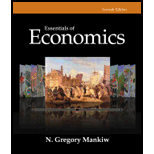
Essentials of Economics (MindTap Course List)
7th Edition
ISBN: 9781285165950
Author: N. Gregory Mankiw
Publisher: Cengage Learning
expand_more
expand_more
format_list_bulleted
Question
Chapter 24, Problem 8PA
Subpart (a):
To determine
The initial effect of tax reduction on aggregate
Subpart (b):
To determine
The total effects of tax reduction on aggregate demand.
Subpart (c):
To determine
The comparison of total effects of tax reduction to the total effects of increase in Government purchases.
Subpart (d):
To determine
How can the Government increase aggregate demand without changing the government’s budget deficit.
Expert Solution & Answer
Want to see the full answer?
Check out a sample textbook solution
Students have asked these similar questions
The only fill in the blank options are Larger MPC or Smaller MPC
The federal government implements an expansionary fiscal policy of increased spending and decreased taxes. Policy advisors predict output will increase 4% but are surprised when only 3% growth occurs. What might account for the fact that GDP increased by less than the multiplier predicted?
a. Policy advisors' calculation of MPS was too high
b. The aggregate supply curve was perfectly elastic
c. Foreign purchases of domestic goods was greater than expected due to a devalued currency
d. Consumption increases more than expected because of the decrease in taxes
e. Investment decreased due to rising interest rates
Suppose there are both multiplier and crowding out effects but without any accelerator effects. An increase in government expenditures would
a. always shift aggregate demand right by a smaller amount than the increase in government expenditures.
b. always shift aggregate demand right by a larger amount than the increase in government expenditures.
c. shift aggregate demand right by a larger, equal, or smaller amount than the increase in government expenditures.
d. always shift aggregate demand right by the same amount as the increase in government expenditures.
Chapter 24 Solutions
Essentials of Economics (MindTap Course List)
Knowledge Booster
Similar questions
- Assume there is a decrease in the aggregate demand, if expansionary fiscal policy is being used, the following action could be taken a. increase consumption by raising disposable income through cuts in personal taxes or payroll taxes b. increasing government spending by raising after-tax profits through cuts in business taxes c. increase government purchases through increased Federal Government spending on final goods and services and raising grants to state and local government to increase their expenditures on final goods and services d. All of the abovearrow_forwardConsider two policies, a tax cut that lasts for only 2 years and a tax cut that is expected to be permanent. Which policy will stimulate greater spending by consumers? Which policy will have the greater impact on aggregate demand? Select one: a. permanent tax cut; 2-year tax cut b. permanent tax cut; permanent tax cut c. 2-year tax cut; 2-year tax cut d. 2-year tax cut; permanent tax cutarrow_forward2. Is each of the following policies an example of expansionary or contractionary fiscal policy? Explain your answer in terms of the effect on aggregate demand. a. The government slashes funding for the environment b. The government raises taxes on households. c. The government decides to fill gaps in Medicare by making it available to more people.arrow_forward
- Suppose the government, in an effort to avoid an increase in the deficit, votes for a budget neutral tax cut policy. Assume the marginal propensity to consume (MPC) is equal to 0.75 and taxes are cut by $15 billion. Round answers to the nearest billion, and specify decreases as a negative number. By how much will government spending change? change in government spending: $ What is the resulting change in the equilibrium level of real GDP? change in equilibrium level of real GDP: $ billion billionarrow_forwardRight now many economies in the world are experiencing a downturn due to the Corona Virus.a) What kind of fiscal policy can governments use to address the decline? b) What actions will be taken by the government in implementing the fiscal policy that you described in part a? c) What will be the effect on Aggregate Demand (if any) as a result of the actions taken in part b?d) What will be the effect on Aggregate Supply (if any) as a result of the actions taken in part b?arrow_forwardWhich of the following can tax cuts influence? a. aggregate demand and aggregate supply b. aggregate demand but not aggregate supply c. aggregate supply but not aggregate demand d. neither aggregate demand nor aggregate supplyarrow_forward
- a) What are the three fiscal policy tools and how would each be used to counter a contractionary gap? b) True or False and explain: Fiscal Policy is effective at reducing the duration of an economic contraction. c) If the spending multiplier is 2.5 and the economy is in a $500 billion contractionary gap, how much should I increase government purchases to eliminate the gap? d) Continuing with c, if the MPC is 0.8, how much would I need to increase transfer payments to eliminate the $500 billion contractionary gap? e) True or False and explain: Households always react to tax changes in a predictable manner. Module 6: Deficits and the Debt. a) Distinguish between deficit and debt. b) Explain what crowding out is and why it reduces the impact of fiscal stimulus. c) True or false and explain: The national debt represents a threat of bankruptcy. (For d and e) Suppose the interest on the debt was $600 billion. If interest is paid domestically, 90% will be spent domestically (the remainder is…arrow_forwardSuppose actual real GDP is $5.49 trillion, potential real GDP is $12.48 trillion, and the marginal propensity to consume is 0.76. If we ignore price effects, and if the government already decided to increase its spending by $1.07 trillion, by how many trillions of dollars should the government change its lump sum taxes to fix the gap? (Round this to two digits after the decimal and enter this value as either a positive value or a negative value without the dollar sign.)arrow_forwardExplain how the implementation of this policy is related to the simple spending multiplier. Explain how the fiscal policy could solve the problem of unemployment.arrow_forward
- Macmillan Learning . Suppose the government, in an effort to avoid an increase in the deficit, votes for a budget neutral tax cut policy. Assume the marginal propensity to consume (MPC) is equal to 0.75 and taxes are cut by $15 billion. Round answers to the nearest billion, and specify decreases as a negative number. By how much will government spending change? change in government spending: S What is the resulting change in the equilibrium level of real GDP? change in equilibrium level of real GDP: $ billion billionarrow_forwardSuppose that real GDP is currently $19.3 trillion, potential GDP is $23.0 trillion, the government purchases multiplier is 1.6, and the tax multiplier is -1.6. Holding other factors (such as prices and interest rates) constant, how will taxes (T) need to change to bring the economy to equilibrium at potential GDP? Provide your answer in dollars measured in trillions rounded to two decimal places. Use a negative sign for negative changes. Do not include any symbols, such as "S," "," "%," or "," in your answer. Your Answer: Answerarrow_forwardPLEASE ANSWER THE QUESTIONS. * the attached photo is just connected to these questions. * If the current real GDP is P700 billion, which of the following policies would bring the economy to potential output? a. increase government spending by P25 billion b. increase government spending by P100 billion c. increase government spending by P20 billion d. decrease government spending by P100 billion. The tax multiplier is: a. -0.8 b. -1.25 c. -5 d. -4arrow_forward
arrow_back_ios
SEE MORE QUESTIONS
arrow_forward_ios
Recommended textbooks for you
 Economics (MindTap Course List)EconomicsISBN:9781337617383Author:Roger A. ArnoldPublisher:Cengage Learning
Economics (MindTap Course List)EconomicsISBN:9781337617383Author:Roger A. ArnoldPublisher:Cengage Learning
 Exploring EconomicsEconomicsISBN:9781544336329Author:Robert L. SextonPublisher:SAGE Publications, Inc
Exploring EconomicsEconomicsISBN:9781544336329Author:Robert L. SextonPublisher:SAGE Publications, Inc
 Survey of Economics (MindTap Course List)EconomicsISBN:9781305260948Author:Irvin B. TuckerPublisher:Cengage Learning
Survey of Economics (MindTap Course List)EconomicsISBN:9781305260948Author:Irvin B. TuckerPublisher:Cengage Learning

Economics (MindTap Course List)
Economics
ISBN:9781337617383
Author:Roger A. Arnold
Publisher:Cengage Learning


Exploring Economics
Economics
ISBN:9781544336329
Author:Robert L. Sexton
Publisher:SAGE Publications, Inc


Survey of Economics (MindTap Course List)
Economics
ISBN:9781305260948
Author:Irvin B. Tucker
Publisher:Cengage Learning
